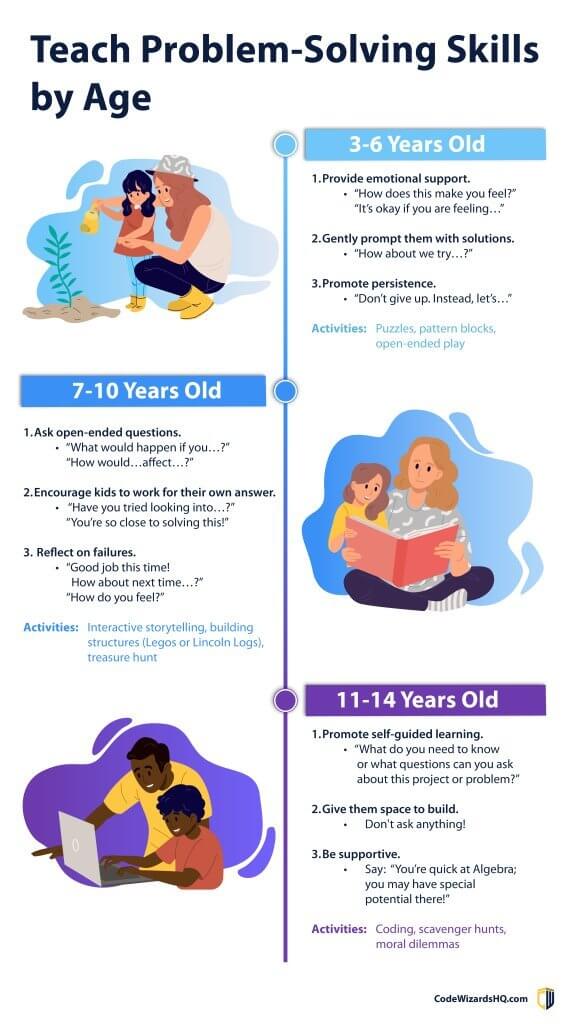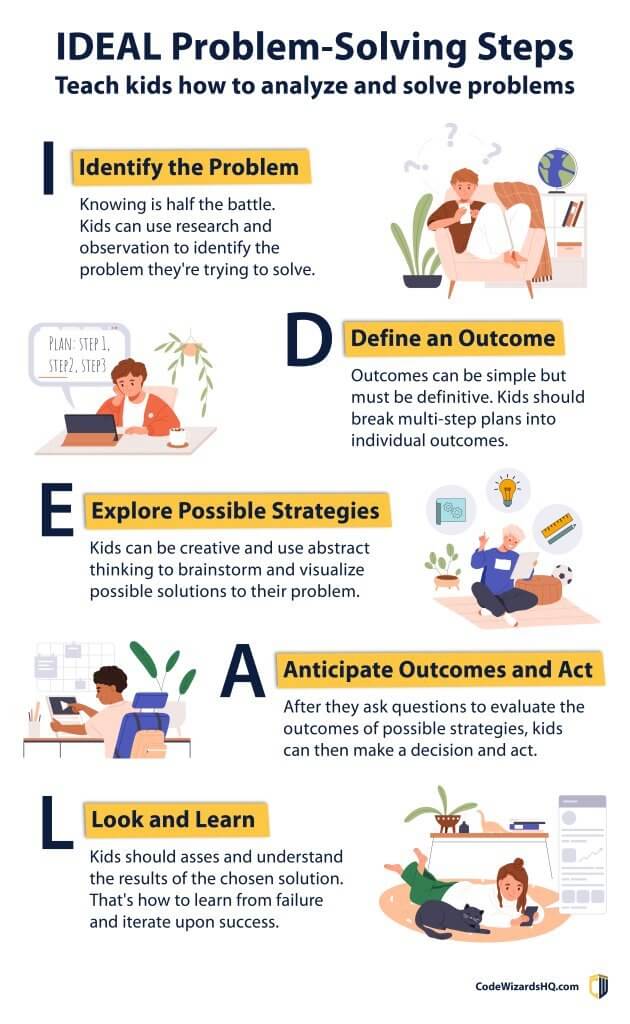Here’s a riddle: what do putting together IKEA furniture and creating artificial intelligence have in common?
Sure, both are challenging projects that require long stretches of time to assemble. But believe it or not, building both furniture and AI require the same fundamental set of skills: problem-solving.
Solving problems is critical in every part of life. Whether at work or in life, you’ll need the adaptability and knowledge to figure out solutions to all sorts of obstacles. In fact, studies have shown that problem-solving skills enhance innovation and opportunity perception. That’s why teaching problem-solving for kids is important: they will need these skills to succeed in work and life alike.
From coding classes for kids to treasure hunts – read on to learn about problem-solving activities for kids and why they matter.
Problem-Solving for Kids and Why It’s Important
So what is problem-solving for kids? While adults deal with issues in daily life, problem-solving steps for kids might look different since they’re still learning how to handle challenges.
Problem-solving skills for kids looks like:
- Resilience. For younger kids especially, not giving up or getting overly frustrated when faced with tough situations is the first step. Thankfully, practice makes perfect: easy problem-solving tasks for kids can help them celebrate small successes and be willing to keep working the next time they run into a hard problem.
- Creative thinking. Creative problem-solving for kids means thinking outside of the box of their probably limited experiences and being willing to experiment. Grasping how to use tools together for a different purpose or combining colors to make a new color: these are examples of creative problem-solving situations for kids that can inspire them to find non-obvious solutions when faced with difficult tasks.
- Collaboration. Sometimes, the best answer comes from putting heads together. Understanding how to work alongside others is a key ability that will not only produce better results but also strengthen relationships among your child and their peers!
Why does this matter? For kids, problem-solving is about more than just finding the solution to puzzles or games. It’s about developing the skills that will help them persist in the face of difficulty, being able to thrive in teamwork settings, and thinking three-dimensionally about issues in the real world.
How do you teach a child problem-solving?
3-6 Years Old
Young kids love to play and experiment, which is the perfect opportunity for problem-solving kids to get their first shot at finding solutions. As a parent, you should nurture their interests and provide them with a safe place to explore. Here are some steps to try:
- Provide emotional support. Young kids can be more prone to feeling upset when they fail. You should validate their emotions and let them talk about how they feel.
- Ask: “How does this make you feel?” “It’s okay if you are feeling…”
- Gently prompt them with solutions. If your kid is struggling to see the solution to a problem, a gentle suggestion on what to try can help them take the next step might be exactly what they need. If they can solve something with your suggestions, they will most likely still feel accomplished and appreciative of your help.
- Ask: “How about we try…?”
- Promote persistence. Trying and failing is a natural part of play. Encourage your kids to try again instead of giving up when they get frustrated. Laying a healthy emotional framework for handling failure will help them in all areas of life.
- Say: “Don’t give up. Instead, let’s…”
The key step in encouraging problem-solving with kids so young is making sure they feel supported through the trial and error process. Failure should be normalized as a part of play so that they’ll be ready to try again.
Looking for some problem-solving games for kids/children in this age group? Puzzles are great visual problem-solving games for kids that allow them to (literally) piece together the solution through memorization, strategies, and trial and error.
7-10 Years Old
As your kid gets older, they acquire more knowledge and strategies they can apply to obstacles. Here are some ways to guide a 7-10 year old through solving problems.
- Ask open-ended questions. Instead of giving suggestions as you would for a younger kid, try asking open-ended questions that encourage kids to think for themselves. Hypotheticals are a great way to get their thinking on the right track.
- Ask: “What would happen if you…?” “How would…affect…?”
- Encourage kids to work for their own answer. This can look like encouraging words, teamwork, or just rewarding them for coming up with a working solution. With the right problem-solving activity for kids, you might be able to make the reward the result of their hard work!
- Say: “Have you tried looking into…?” “You’re so close to solving this!”
- Reflect on failures. Learning from your failures is how you do better the next time. If your kid fails at a task or breaks something, ask them guiding questions to suggest alternative ways to accomplish something.
- Say: “Good job this time! How about next time…?” “How do you feel?”
Here are two good problem-solving games for kids aged 7 to 10:
- Interactive storytelling. Since kids at this age are getting into reading, you can leverage that into a fun communal storytelling experience. Whether this is playing out a story through pretend, an age-appropriate computer game, or even something more rules-heavy like playing in a tabletop roleplaying game, interactive storytelling is a great way to get kids to think from different perspectives and use the tools they are offered in-universe to resolve troubles.
- Building projects. Whether it’s a physical building kit like Lincoln Logs or Lego or introducing them to games like Minecraft where you can experiment with building or coding, allowing a kid to get creative while building is a great way to inspire them to solve problems in a virtual world.
Group problem-solving games for kids can be even better, as they encourage collaboration and teamwork!
11-14 Years Old
At this age, your kid will be more independent than before. Here’s how to encourage better problem-solving strategies for kids in their preteens to teenage years:
- Promote self-guided learning. Expanding your child’s knowledge base better equips them with a toolkit for future problem-solving. Reading books, reputable online articles, and going to the library are great ways for your kids to absorb more information about topics they’re passionate about.
- Give them space to build. While it’s nice to give your kids projects, 11-14 is also a good age for them to drill down on their own interests. Give them the space to form their own opinions on issues and empower them with the tools to pursue whatever they might be passionate about.
- Be supportive. The best thing parents can give their teenagers is support. Be their biggest cheerleader during any projects and problem-solving attempts!
When it comes to good activities for younger teens, learning how to code is a great way to develop problem-solving skills. It encourages trial and error, improvement through repetition, and creative thinking, in addition to being a valuable skill in today’s technology-centric world. Read on and you’ll find out why kids need to learn coding in order to improve their problem-solving skills.
With an idea of how to teach problem-solving skills for kids, let’s take a look at the basic steps of how to solve a problem.
5 Basic Steps in Problem-Solving (IDEAL)
To understand how problem-solving games for kids can be a fun, immersive experience, you should understand the fundamental steps of problem-solving. In 1984, Bransford and Stein published one of the most popular and well-regarded problem-solving methods. It’s used both in industry and in education to help various learners establish a problem, generate solutions, and move forward quickly and efficiently. By teaching your child the IDEAL model, you can provide them with a set of steps to approach a problem with confidence.
These five steps will help your kid outline a problem-solving process, no matter what kind of issue they are facing.
- I: Identify the Problem
- D: Define an Outcome
- E: Explore Possible Strategies
- A: Anticipate Outcomes and Act
- L: Look and Learn
Step 1: Identify the Problem
Knowing is half the battle. Without a clear understanding of the issue, your kid won’t be able to find a solution. So what are some ways to better identify and understand a problem at hand?
- Research. Nowadays, there are an endless array of tools available to curious kids who want to learn more about any subject. Whether it’s the internet, the library, or asking a teacher or other trusted adult for more information, there are many ways to gain a comprehensive understanding of most subjects.
- Observation. Sometimes, you have to see something to believe it! If your kid is investigating a real-world phenomenon, observing it in real life can help them hone observational skills and pattern-identifying abilities.
- Act! For kids who like to learn hands-on, just diving into the rest of the problem-solving process can be educational in its own way. Sometimes you need to break a few eggs to make the omelet (of problem-solving).
Step 2: Define an Outcome
Once you have an understanding of the problem, you’ll need to know what kind of solution you are looking for. This doesn’t have to be complicated, but it does have to be definitive.
For example:
- “My goal is for this robot to be able to walk.”
- “I want to complete this puzzle.”
- “I want to code a responsive website.”
Outcomes can be as simple or complicated as your kid wants them to be. Breaking a multi-step plan down into individual outcomes can sometimes help make it less intimidating and more manageable!
Step 3: Explore Possible Strategies
After defining the outcome you want, you’ll need to translate it into a concrete plan. Here are a few ways to get the creative juices flowing:
- Brainstorm. Taking time to brainstorm, especially in groups, is a great step toward generating creative answers. Don’t be afraid to encourage ideas that might seem unrealistic or unusable, as these are all steps toward generating a solution.
- Draw something. Even if your kid isn’t artistic, sketching something out by hand can jumpstart their imagination and help them visualize what a complete solution can look like.
- Jot it down. On the other end of the spectrum: if you know your kid likes to express thoughts through writing, reminding them to write their thoughts down is a helpful first step to organizing seemingly unrelated ideas.
Step 4: Anticipate Outcomes & Act
Now that your problem-solving activities for kids have concluded their planning phase, there’s only one thing left to do: execute.
If your child has a more cautious personality, you might have to actively encourage the transition from planning to action. While there’s always the risk of failure in bringing a plan on paper into reality, the lessons learned afterward are invaluable.
The best you can do is prepare your child for failure as much as success. Training them to have a healthy outlook on failure is the first step in encouraging problem-solving kids to continue their pursuits.
Step 5: Look and Learn
So the plan has been executed. Does that mean this is the end of the line?
Definitely not. Whether your kid fails or succeeds, they will need to assess and understand their results.
- Failure:
- What went wrong?
- How can you fix the issue(s) next time?
- Were there any unfixable issues? How can you control another experiment for those?
- Success:
- What worked and why did it work?
- Are these results replicable?
- Were there any issues? How can you fix them next time?
Teaching kids problem-solving isn’t just about getting them to solve problems. It should also teach them how to learn from failure and iterate upon success.
Fun Problem-Solving Activities For Kids
Looking to introduce some problem-solving situations for kids in a fun, accessible way? Check out these resources.
- MindGames.com (free)
- Topmarks Education Games (free)
- Scratch: coding for kids (free)
Coding Teaches Problem-Solving Skills
Coding teaches problem-solving skills for kids from all angles. They get the opportunity to iterate through trying and failing, build projects from the ground up with the complex syntax of coding languages, and hone their critical thinking skills through consistent practice. Your child can reap the benefits of coding not just in their professional careers, but also in life.
Of course, it can be challenging to introduce your kids to a difficult topic like coding without the appropriate resources or instruction. CodeWizardsHQ coding programs for kids offer a great gateway for any kid to learn coding and practice their problem-solving skills. With a core curriculum designed for kids aged 8-18, specialty tracks for specific coding languages, and coding expert teachers who are available to help both inside and outside of class, we’ve got you and your kid covered. Sign up for our coding programs for kids for a 100% risk-free trial!


